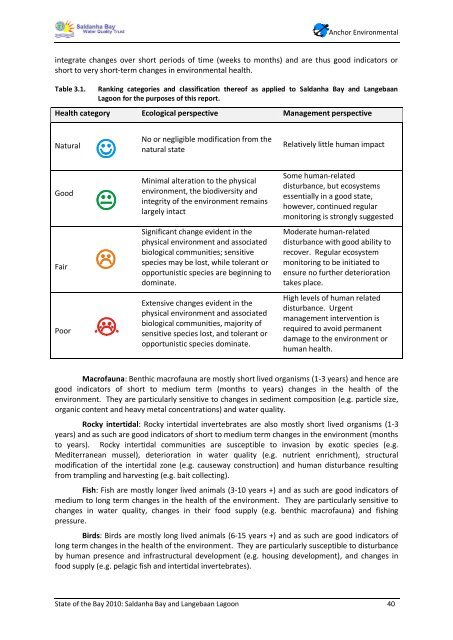State of the Bay Report 2010-Final - Anchor Environmental
State of the Bay Report 2010-Final - Anchor Environmental
State of the Bay Report 2010-Final - Anchor Environmental
Create successful ePaper yourself
Turn your PDF publications into a flip-book with our unique Google optimized e-Paper software.
<strong>Anchor</strong> <strong>Environmental</strong><br />
integrate changes over short periods <strong>of</strong> time (weeks to months) and are thus good indicators or<br />
short to very short-term changes in environmental health.<br />
Table 3.1. Ranking categories and classification <strong>the</strong>re<strong>of</strong> as applied to Saldanha <strong>Bay</strong> and Langebaan<br />
Lagoon for <strong>the</strong> purposes <strong>of</strong> this report.<br />
Health category Ecological perspective Management perspective<br />
Natural<br />
Good<br />
Fair<br />
Poor<br />
<br />
<br />
<br />
<br />
No or negligible modification from <strong>the</strong><br />
natural state<br />
Minimal alteration to <strong>the</strong> physical<br />
environment, <strong>the</strong> biodiversity and<br />
integrity <strong>of</strong> <strong>the</strong> environment remains<br />
largely intact<br />
Significant change evident in <strong>the</strong><br />
physical environment and associated<br />
biological communities; sensitive<br />
species may be lost, while tolerant or<br />
opportunistic species are beginning to<br />
dominate.<br />
Extensive changes evident in <strong>the</strong><br />
physical environment and associated<br />
biological communities, majority <strong>of</strong><br />
sensitive species lost, and tolerant or<br />
opportunistic species dominate.<br />
Relatively little human impact<br />
Some human-related<br />
disturbance, but ecosystems<br />
essentially in a good state,<br />
however, continued regular<br />
monitoring is strongly suggested<br />
Moderate human-related<br />
disturbance with good ability to<br />
recover. Regular ecosystem<br />
monitoring to be initiated to<br />
ensure no fur<strong>the</strong>r deterioration<br />
takes place.<br />
High levels <strong>of</strong> human related<br />
disturbance. Urgent<br />
management intervention is<br />
required to avoid permanent<br />
damage to <strong>the</strong> environment or<br />
human health.<br />
Macr<strong>of</strong>auna: Benthic macr<strong>of</strong>auna are mostly short lived organisms (1-3 years) and hence are<br />
good indicators <strong>of</strong> short to medium term (months to years) changes in <strong>the</strong> health <strong>of</strong> <strong>the</strong><br />
environment. They are particularly sensitive to changes in sediment composition (e.g. particle size,<br />
organic content and heavy metal concentrations) and water quality.<br />
Rocky intertidal: Rocky intertidal invertebrates are also mostly short lived organisms (1-3<br />
years) and as such are good indicators <strong>of</strong> short to medium term changes in <strong>the</strong> environment (months<br />
to years). Rocky intertidal communities are susceptible to invasion by exotic species (e.g.<br />
Mediterranean mussel), deterioration in water quality (e.g. nutrient enrichment), structural<br />
modification <strong>of</strong> <strong>the</strong> intertidal zone (e.g. causeway construction) and human disturbance resulting<br />
from trampling and harvesting (e.g. bait collecting).<br />
Fish: Fish are mostly longer lived animals (3-10 years +) and as such are good indicators <strong>of</strong><br />
medium to long term changes in <strong>the</strong> health <strong>of</strong> <strong>the</strong> environment. They are particularly sensitive to<br />
changes in water quality, changes in <strong>the</strong>ir food supply (e.g. benthic macr<strong>of</strong>auna) and fishing<br />
pressure.<br />
Birds: Birds are mostly long lived animals (6-15 years +) and as such are good indicators <strong>of</strong><br />
long term changes in <strong>the</strong> health <strong>of</strong> <strong>the</strong> environment. They are particularly susceptible to disturbance<br />
by human presence and infrastructural development (e.g. housing development), and changes in<br />
food supply (e.g. pelagic fish and intertidal invertebrates).<br />
<strong>State</strong> <strong>of</strong> <strong>the</strong> <strong>Bay</strong> <strong>2010</strong>: Saldanha <strong>Bay</strong> and Langebaan Lagoon 40

















